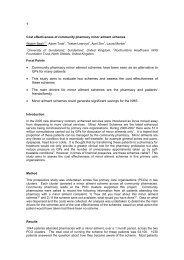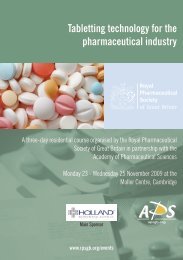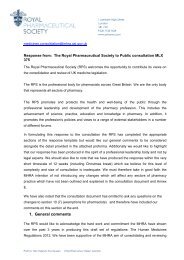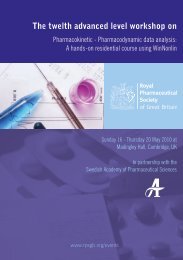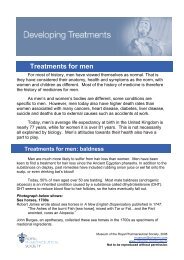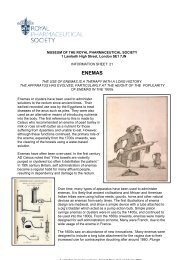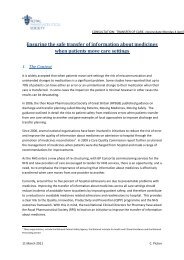Gout - Royal Pharmaceutical Society
Gout - Royal Pharmaceutical Society
Gout - Royal Pharmaceutical Society
You also want an ePaper? Increase the reach of your titles
YUMPU automatically turns print PDFs into web optimized ePapers that Google loves.
<strong>Gout</strong><br />
<strong>Gout</strong> is a very painful form of arthritis that affects people’s joints. It is<br />
caused by too much uric acid, a waste product produced by the body.<br />
Attacks of acute gout are agonizingly painful, caused by uric acid crystals<br />
forming around the sufferer’s joints. It usually affects one joint at a time,<br />
most often the big toe. Today 90% of gout sufferers are men. Although<br />
there is no cure for gout, it can now be controlled very effectively through<br />
regular medication.<br />
The word ‘gout’ was first written in English in the year 1290:<br />
“There cam a goute In is kneo, Of Anguische gret…So longue, that is kneo<br />
to swal”<br />
[there came a gout in his knee of anguish great, so long that his knee<br />
swelled]<br />
In the past, people associated gout with the wealthy – those that could<br />
afford rich food and drink. Famous sufferers of gout include King Henry<br />
VIII of England (1491-1547), the famous dictionary author Samuel Johnson<br />
(1709-1784), American President Thomas Jefferson (1743-1826), and<br />
Joseph Banks, the botanist on Captain Cook’s first voyage (1743-1820).<br />
Our stereotype of a gout sufferer as a large red-faced man drinking port<br />
mainly comes from the cartoons of the 1700s. However, the Ancient<br />
Greeks connected gout and good living over 2000 years before this.<br />
Researchers today have confirmed that drinking port and eating too much<br />
meat does provoke attacks of gout in some people.<br />
Museum of the <strong>Royal</strong> <strong>Pharmaceutical</strong> <strong>Society</strong>, 2006<br />
museum@rpharms.com<br />
www.rpharms.com/museum<br />
Not to be reproduced without permission
A stereotypical gout sufferer, from Punch cures the <strong>Gout</strong>, the Colic and the ‘TISICK (tuberculosis)<br />
by James Gillray, published in 1799.<br />
Museum of the <strong>Royal</strong> <strong>Pharmaceutical</strong> <strong>Society</strong>, 2006<br />
museum@rpharms.com<br />
www.rpharms.com/museum<br />
Not to be reproduced without permission
Ancient civilizations<br />
People have recognised gout as a specific disease for thousands of years. Many<br />
ancient writers explained gout in ways that still<br />
make sense to us today.<br />
The Ancient Egyptians identified gout as a disease in<br />
around 2650 B.C.<br />
There is prehistoric evidence that people in Ancient<br />
China treated rheumatic disease, including gout, with<br />
acupuncture. They also used “moxibustion”, a<br />
technique where they burnt small cones of the dried<br />
herb Artemisia on the affected joint.<br />
Both Ancient Greek and Roman medical writers<br />
included gout in their books.<br />
Artemesia<br />
The famous Greek doctor Hippocrates (460-375 B.C.) thought gout was caused by too much<br />
phlegm settling in the joints. This derived from his belief that every person‟s body contained<br />
four humours that had to stay in balance to maintain good health – one was phlegm. He called<br />
gout “the unwalkable disease” and “the arthritis of the rich”, and blamed it on an excess of<br />
wine, food and sex. His observations that gout tends to occur in post-pubertal males and postmenopausal<br />
women still hold true today.<br />
The Roman physician Celsus (25BC- A.D.50) used the Latin words podagra (seizure in the<br />
foot) and chiragra (seizure in the hand) to describe a gout-like disease.<br />
Galen (129- 216 A.D.) was the first doctor to describe the tophi that some gout sufferers<br />
experience – lumps of crystallized uric acid under the skin. Aretaeus (1 st century A.D.)<br />
suggested there was a toxic substance in the blood of gouty patients.<br />
Colchicum<br />
A treatment through the ages<br />
In the Byzantine Empire surrounding today‟s city of Istanbul, physicians introduced a plant<br />
called Colchicum autumnale, commonly known as meadow or autumn crocus, as a specific<br />
treatment to ease the pain and inflammation of gout. Alexander of Tralles (6 th century A.D.)<br />
used the corm (bulb) of the plant. Paul of Aegina (7 th century A.D.) used infusions of the whole<br />
plant. Some sufferers still take colchichine, an active ingredient in colchicum, today.<br />
1) Colchicum corm<br />
The whole corms come from a collection of materia medica<br />
crude drug ingredients formed by John Burges, a physician in<br />
the 1700s. The sliced corm comes from a study collection<br />
which was used by Dr Stephen I. Ankier as part of his<br />
pharmacy apprenticeship in 1959.<br />
Museum of the <strong>Royal</strong> <strong>Pharmaceutical</strong> <strong>Society</strong>, 2006<br />
museum@rpharms.com<br />
www.rpharms.com/museum<br />
Not to be reproduced without permission
2) Later colchicum medicines<br />
Blair’s <strong>Gout</strong> and Rheumatic Pills claimed to cure gout. The ingredients<br />
included colchicum corm.<br />
Wooldrige’s <strong>Gout</strong> and Rheumatic Tincture includes colchichine,<br />
alongside potassium acetate, potassium bicarbonate and potassium iodide<br />
which were claimed to reduce the acidity of the patient‟s urine.<br />
1930s, Wooldridge‟s Medicine Company Ltd.<br />
Colchicum wine, Stafford Allen and Sons Ltd, 1950s<br />
Liquid extract of colchicum corm, Stafford Allen and Sons Ltd, mid 20 th<br />
century<br />
Eade’s Pills contained colchicum corm, extract of colchicum, aloes, and guaiacum resin.<br />
They were first made in the 1800s and withdrawn from the UK in 1972.<br />
George Eade Ltd, late 20 th century South African example.<br />
<strong>Gout</strong> in Britain<br />
Early ideas and treatments, 1200s-1700s<br />
The word „gout‟ comes from the Latin word „gutta‟ meaning a drop. This followed from the<br />
Ancient Greek idea that every person‟s body contained four humours that had to stay in<br />
balance to maintain good health. Doctors explained that gout was caused when one of the<br />
humours “dropped” or flowed into a joint causing pain and swelling. As a result, many people<br />
continued to follow the ancient remedies of bleeding and purging to try to restore this balance.<br />
„Gutta‟ for „gout‟ was first used by the Dominican monk, Randolphus of Bocking, the chaplain to<br />
the Bishop of Chichester (1197-1258).<br />
3) Nicholas Culpeper, writing in 1653, suggested Tartar Pills of<br />
Quercetanus, and Blessed Pills to treat gout. Both types of pills<br />
acted as a purge, following the ancient tradition of ridding the body<br />
of toxins. A treatise on gout by a French physician Theodore<br />
Turquet de Mayerne, dated 1677, also recommended purges,<br />
including Cochia Minor Pills, which were made from aloes,<br />
scammony, colcynth, oil of cloves and syrup of buckthorn.<br />
P: BENEDICT, Pilulae Benedictae, Blessed Pills jar, 1720-1740<br />
P: COCH: MIN, Pilulae Cochiae Minores Cochia minor pills jar,<br />
1750-1770<br />
Museum of the <strong>Royal</strong> <strong>Pharmaceutical</strong> <strong>Society</strong>, 2006<br />
museum@rpharms.com<br />
www.rpharms.com/museum<br />
Not to be reproduced without permission
Medical men also suggested different plant-based remedies:<br />
Horse radish Armoracia rusticana<br />
If bruised and laid to a part grieved with the sciatica, gout, joint-ache or<br />
hard swellings of the spleen and liver, it doth wonderfully help them all.<br />
Nicholas Culpeper, 1653<br />
Wild strawberry Fragaria vesca<br />
By the 1700s, Swedish botanist Carl Linnaeus<br />
(1707-1778) claimed that his strawberries-only<br />
diet had cured his gout.<br />
<strong>Gout</strong>-herb Ægopodium podagraria<br />
Also called ground elder.<br />
‘the very bearing of it about one eases the pains of the gout and<br />
defends him that bears it from the disease.’<br />
Nicholas Culpeper, 1653<br />
Meanwhile in Europe, Lorenz Fries, writing in 1518 had a different suggestion for an internal<br />
and external treatment:<br />
Roast a fat old goose and stuff with chopped kittens, lard, incense, wax and flour of rye.<br />
This must all be eaten, and the dripping applied to the painful joints.<br />
William Shakespeare‟s recommendation seems to be to avoid doctors:<br />
One that's sick o' th' gout, had rather Groan so in perplexity than be curs'd By th' sure<br />
physician death. Cymbeline, 1611<br />
4) Thomas Dover (1660-1742) invented his Dover’s Powders to treat the pain caused by gout.<br />
The main ingredients were powdered ipecachuana and opium. Dover gave the original recipe<br />
in his book The Ancient Physician’s Legacy to his Country (1732). He made the claim for his<br />
medicine that “in two or three Hours, at farthest, the Patient will be perfectly free from Pain.”<br />
Dover’s Powders, mid-1800s<br />
From a medicine chest<br />
Museum of the <strong>Royal</strong> <strong>Pharmaceutical</strong> <strong>Society</strong>, 2006<br />
museum@rpharms.com<br />
www.rpharms.com/museum<br />
Not to be reproduced without permission
The stereotype<br />
Suffering from gout in the 1700s<br />
Our image of a gout sufferer as a male wealthy glutton probably<br />
stems from the caricatures of the 1700s. In 1771, William<br />
Cullen wrote “The gout attacks men of especially robust and<br />
large bodies, men of large heads.”<br />
Some historians have argued that, as gout was mainly a disease<br />
suffered by men in power with extravagant lifestyles, poorer<br />
people aspired to say that they suffered from it too.<br />
Recently medical researchers confirmed that darker coloured<br />
alcoholic drinks are more likely to trigger acute attacks. This<br />
means that the popular 1700s drinks of port, claret, burgundy<br />
and porter were likely to have increased people‟s suffering.<br />
In addition to the ancient theories of balancing the body using sweating, bleeding, purging and<br />
blistering, scientists became interested in other “lifestyle” treatments.<br />
5) The Botanic Macaroni, probably drawn by Robert Dighton, published 1772<br />
Joseph Banks, the botanist on Captain Cook‟s first voyage to Australia, was a gout sufferer.<br />
This cartoon shows him with a massively swollen leg. Banks took a rhubarb preparation to<br />
purge his system, but also made trips to Bath to take the waters.<br />
Spa treatments were popular in the 1700s, and were advised by leading doctors including<br />
William Cadogan in A dissertation on the gout, and all chronic diseases (1771) which went<br />
through nine editions in 2 years. Samuel Johnson (1709-1794) treated what he believed to be<br />
gout by soaking his feet in cold water. Dr William Heberden the Elder (1710-1801) thought that<br />
ocean bathing along with the fresh air and sunshine it would bring would be more beneficial<br />
than spa bathing.<br />
Dr William Stukeley (1687-1765) and doctors in the 1700s believed that diet and exercise<br />
could play a part, and that a balanced lifestyle was important:<br />
The golden medium seems right for gout in every thing, liquor, eating, exercise,<br />
evacuations. Drink above water, below the strength of wine ie small beer.<br />
Museum of the <strong>Royal</strong> <strong>Pharmaceutical</strong> <strong>Society</strong>, 2006<br />
museum@rpharms.com<br />
www.rpharms.com/museum<br />
Not to be reproduced without permission
The science<br />
Starting to understand the disease<br />
Sir Alfred Garrod (1819-1907) first identified uric acid as the<br />
“specific morbid humour” that caused gout. He also devised the<br />
uric acid thread test, which depended on the crystallization of urate<br />
(one of the forms of uric acid) on linen thread. In his milestone<br />
book The Nature and Treatment of <strong>Gout</strong> and Rheumatic <strong>Gout</strong><br />
published in 1859, he wrote:<br />
‘the deposited urate of soda may be looked upon as the<br />
cause, and not the effect, of the gouty inflammation. „<br />
Earlier scientists began to investigate gout in detail when technology allowed them to do so. In<br />
1679, Antoni van Leeuwenhoek (1632-1723), inventor of one of the first microscopes, first<br />
described the appearance of the crystals from a gouty tophus (lumps of crystallized uric acid<br />
under the skin). In 1797, the English chemist William Wollaston demonstrated urate in a<br />
tophus from his own ear.<br />
Medical men continued to advise that patients should follow a diet that avoided urate-forming<br />
items. Reverend Sydney Smith (1771-1845) wrote in 1829, likening food and wine to beautiful<br />
women:<br />
‘The sufferer must enter into a solemn pact with his stomach to relinquish all serious<br />
flirtation with the sirens of the kitchen and the houris of the wine cellar.’<br />
Brand name medicines<br />
A market for gout treatments<br />
The earliest brand name medicines were “cure-alls”, which claimed to treat gout alongside<br />
many other conditions.<br />
6) Daffy's Elixir “the Health-Bringing Drink” was invented by Reverend Thomas Daffy in<br />
around 1650. Although its ingredients remained secret, it was a laxative and probably<br />
contained senna, guaiacum, elecampane root, aniseed, caraway seed, coriander seeds,<br />
liquorice root, raisins and brandy. As well as gout, it was sold to treat a wide range of<br />
conditions including dropsy, kidney stones and convulsions. 1786-1870s<br />
Dealing with the acute pain of a gout attack was all that most medicines could try to do until<br />
recently. This didn‟t stop manufacturers selling hundreds of preparations, both to take<br />
internally and rub on externally.<br />
7) Manufacturers advertised external preparations to treat many painful conditions including<br />
gout, lumbago, rheumatism, chilblains and sciatica.<br />
Museum of the <strong>Royal</strong> <strong>Pharmaceutical</strong> <strong>Society</strong>, 2006<br />
museum@rpharms.com<br />
www.rpharms.com/museum<br />
Not to be reproduced without permission
Durant’s Rheumatic Embrocation, C.Durant,<br />
Boston, Lincolnshire, 1879-1912<br />
Maorix: liniment, Maorix Ltd, 1890-1920, unknown<br />
ingredients described as “containing herbal curative<br />
properties”.<br />
Uritika Nervine Balm, J.Grimshaw and Sons,<br />
around 1900<br />
Betul-Ol: liniment, containing menthol, betula lenta,<br />
spike lavender oil, methyl salicylate, and chloral<br />
hydrate, Anglo American <strong>Pharmaceutical</strong> Company<br />
Ltd. 1916-1931<br />
Little Oriental’s Balm: unknown ingredients, Little‟s Oriental Balm and <strong>Pharmaceutical</strong>s<br />
Ltd, Madras, distributed by Butler and Crispe. 1915-1941<br />
Zox Balm, The Zox Manufacturing Company, unknown ingredients, 1923-1933<br />
St Jacob’s Liniment, with ingredients including camphor, phenol, turpentine and ether.<br />
International Chemical Company Ltd.,1940‟s.<br />
8) From the 1800s, companies marketed specific brand-name medicines for gout and<br />
rheumatism in massive numbers.<br />
Bishop’s <strong>Gout</strong> Varalettes These tablets<br />
included the current gout treatments of<br />
lithium citrate and piperazine, alongside<br />
sodium bicarbonate and tartaric acid to<br />
make them fizz. Early 20 th century. Alfred<br />
Bishop Ltd.<br />
Haycock’s Celebrated <strong>Gout</strong> and<br />
Rheumatic Pills included potassium<br />
iodide, guaiacum resin and powdered<br />
smallage. 1947-1952, Norman E. Taylor.<br />
Charles Gadd’s <strong>Gout</strong> and Rheumatic<br />
Pills, unknown ingredients. C.Gadd and<br />
Son, late 1800s, Armstrong’s Vegetable<br />
<strong>Gout</strong> and Rheumatic Pills Unknown<br />
ingredients. J.M.Smith and Co, 1915-1941<br />
Museum of the <strong>Royal</strong> <strong>Pharmaceutical</strong> <strong>Society</strong>, 2006<br />
museum@rpharms.com<br />
www.rpharms.com/museum<br />
Not to be reproduced without permission
New developments<br />
Investigating other treatment types, 1895-1940s<br />
After X-rays were invented in 1895, scientists were keen to investigate whether they would<br />
work effectively to treat gout. Martindale: the Extra Pharmacopoeia, recommended X-rays as<br />
a gout treatment in its 1915 and 1932 editions. Radium and radioactive waters were also<br />
suggested.<br />
9) Scientists continued to investigate the best way to treat the pain of a gout attack.<br />
Morphine injections, liniments including chloroform, and preparations that included aspirin<br />
(acetylsalicylic acid) came into use. A high dose of a „salicylate‟ drug helped the body to get<br />
rid of uric acid, but it had significant side effects.<br />
Morphine ampoule for injection, French, around 1900<br />
Omega Oil, Omega Chemical Company, containing methyl salicylate, chloroform and<br />
hyoscyamus.<br />
Medical practitioners still supported the idea of purging your system in the early 20 th century,<br />
even though it was no longer based on the ancient four humours theory.<br />
A bacterial toxin is the primary factor. Adequate removal of the intestinal contents at the<br />
commencement of the attack will reduce the symptoms.<br />
Martindale: The Extra Pharmacopoeia, 1932<br />
Urace tablets Newbery and Phillips Ltd, 1940s. Advertised on the packaging for “diseases<br />
arising from excess Uric Acid.” The ingredients were acetylsalicylic acid (aspirin), and<br />
guaiacum resin. Guaiacum is a purgative and was believed to relieve pain and<br />
inflammation during an attack of gout.<br />
Uricure tablets contained acetylsalicylic acid (aspirin), methyl salicylate, and aloin (from<br />
aloes, as a purge). 1943. Unknown manufacturer.<br />
10) Researchers found that phenoquin or cinchophen worked as an alternative painkiller to<br />
aspirin, and also helped the body to get rid of uric acid. Although it worked well on gout, some<br />
people experienced unpleasant after-effects, such as vomiting and severe liver poisoning.<br />
11) At the beginning of the 20 th century, medical practitioners recommended lithium salt<br />
preparations to treat gout. Patients took lithium citrate in water, or as tablets, to make their<br />
urine less acidic.<br />
12) Piperazine was another substance that scientists discovered was more effective than<br />
lithium salts in dissolving uric acid.<br />
Museum of the <strong>Royal</strong> <strong>Pharmaceutical</strong> <strong>Society</strong>, 2006<br />
museum@rpharms.com<br />
www.rpharms.com/museum<br />
Not to be reproduced without permission
Cinchopen tablets, Tabloid brand, Burroughs Wellcome and<br />
Company, mid 20 th century.<br />
Napoleon <strong>Gout</strong> and Rheumatism Powders, including<br />
phenylcinchoninic acid. Early 20 th century. H.R.Napp Ltd<br />
Lithium citrate powder, May and Baker Ltd, 1934-1945<br />
Urodonal powder , Ingredients include hexamine, piperazine<br />
tartrate, lithium carbonate and quinnic acid.<br />
Chatelain Laboratories, early 20 th century.<br />
Pain relief<br />
Post Second World War successes<br />
<strong>Pharmaceutical</strong> scientists have developed new drugs since the Second World War that<br />
patients suffering from acute attacks of gout can take to relieve the pain more effectively.<br />
13) Newer Non-Steroidal Anti-Inflammatory Drugs (NSAIDs) have replaced aspirin as the most<br />
common painkillers. Some forms of pain are registered when body tissues produce chemicals<br />
called prostaglandins. NSAIDs stop the release of prostaglandins and thereby lessen pain.<br />
Phenylbutazone, 1950s<br />
onwards<br />
Phenylbutazone tablets,<br />
Charnwood<br />
<strong>Pharmaceutical</strong>s, 1980s<br />
Indomethacin, 1960s<br />
onwards<br />
Indolar capsules, Lagap<br />
<strong>Pharmaceutical</strong>s Ltd, 2001<br />
Propionic acid derivatives,<br />
1970s onwards<br />
Naproxen EC tablets,<br />
Alphapharma, 2002<br />
Piroxicam tablets, Cox<br />
<strong>Pharmaceutical</strong>s, 2001<br />
Diclofenac, 1980s onwards<br />
Slofenac sustained release<br />
tablets, Valpharma, Italy,<br />
1996<br />
Museum of the <strong>Royal</strong> <strong>Pharmaceutical</strong> <strong>Society</strong>, 2006<br />
museum@rpharms.com<br />
www.rpharms.com/museum<br />
Not to be reproduced without permission
‘Prevention is better than cure’<br />
14) After the Second World War, scientists worked on treatments that would prevent gout.<br />
Probenecid and sulfinpyrazone were two examples, which successfully worked to increase<br />
the amount of uric acid that the body got rid of in urine, rather than leaving it in the patient‟s<br />
system.<br />
Anturan (sulfinpyrazone) tablets, Geigy <strong>Pharmaceutical</strong>s, 1986<br />
15) The major breakthrough was allopurinol. George Hitchings and Gertrude Elion were<br />
awarded the 1988 Nobel prize in medicine for their work in developing the drug. Allopurinol is<br />
an enzyme (xanthine oxidase) inhibitor which limits the body‟s production of uric acid. It has<br />
since become the most frequently-used uric acid lowering drug.<br />
Zyloric tablets, Glaxo Wellcome Operations, 1998-2002<br />
Allopurinol tablets, CP <strong>Pharmaceutical</strong>s Ltd, 2008<br />
In May 2008, febuxostat (Adenuric) was the first new type of gout medicine in four decades to<br />
receive European Union marketing authorisation. It works as a selective xanthine oxidase<br />
inhibitor, lowering the levels of uric acid in the body so that they can‟t form crystals.<br />
Scientists‟ understanding of how to control gout has made a massive difference to sufferers<br />
today.<br />
Effective drugs to lower the level of uric acid in the bloodstream (whether by flushing it<br />
out or limiting its production) mean that the tophi (gouty deposits of uric acid) are rarely<br />
seen.<br />
Researchers are also able to place gout within the context of rheumatology, with the<br />
realisation that there are over 200 different rheumatic disorders with lessons that can be<br />
learnt about treating one from another.<br />
Although doctors have recognised the importance of diet for centuries, health<br />
professionals now understand that gout sufferers should avoid too many purines,<br />
present in meat, seafood and some alcoholic drinks as they increase the build up of uric<br />
acid. Scientists also recognise that, in a few cases, inherited gout is due to a purine<br />
enzyme deficiency, so that the patient‟s body does not process this chemical effective.<br />
Museum of the <strong>Royal</strong> <strong>Pharmaceutical</strong> <strong>Society</strong>, 2006<br />
museum@rpharms.com<br />
www.rpharms.com/museum<br />
Not to be reproduced without permission



